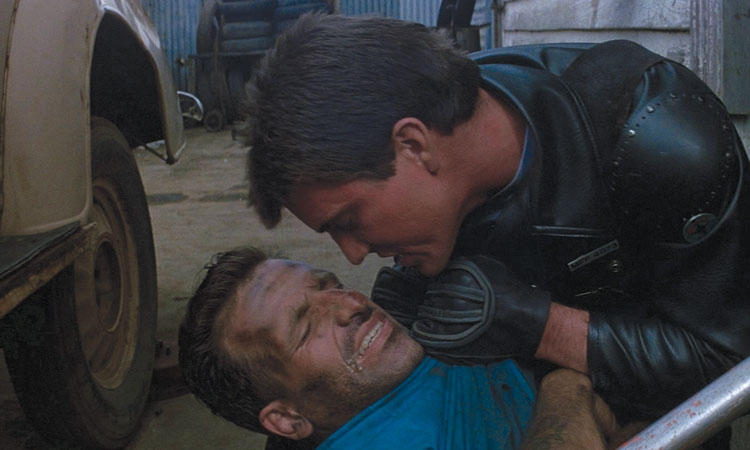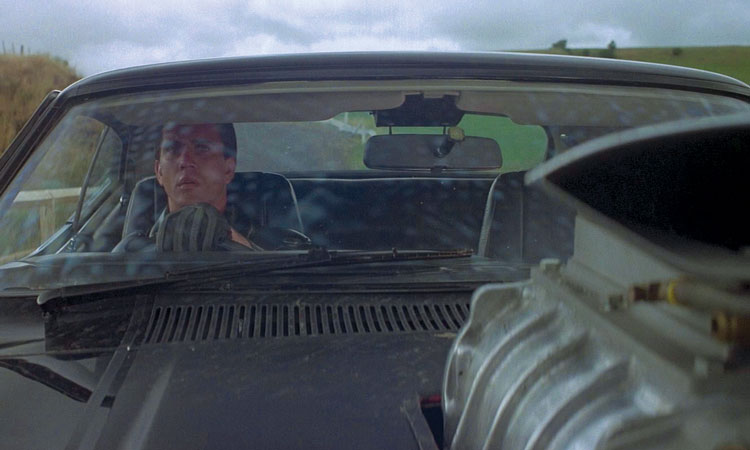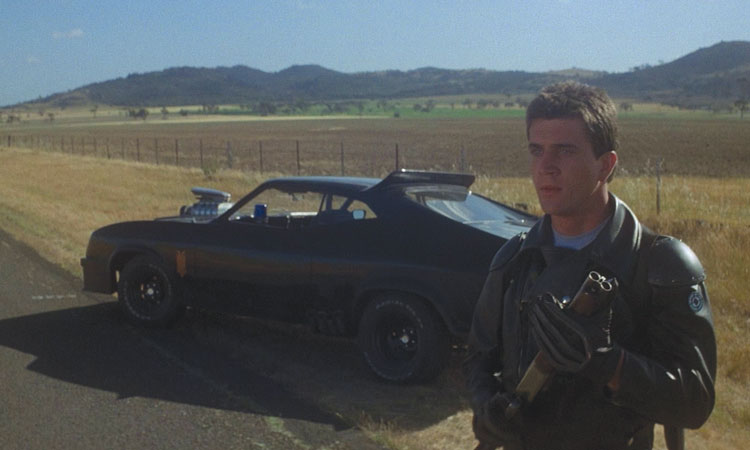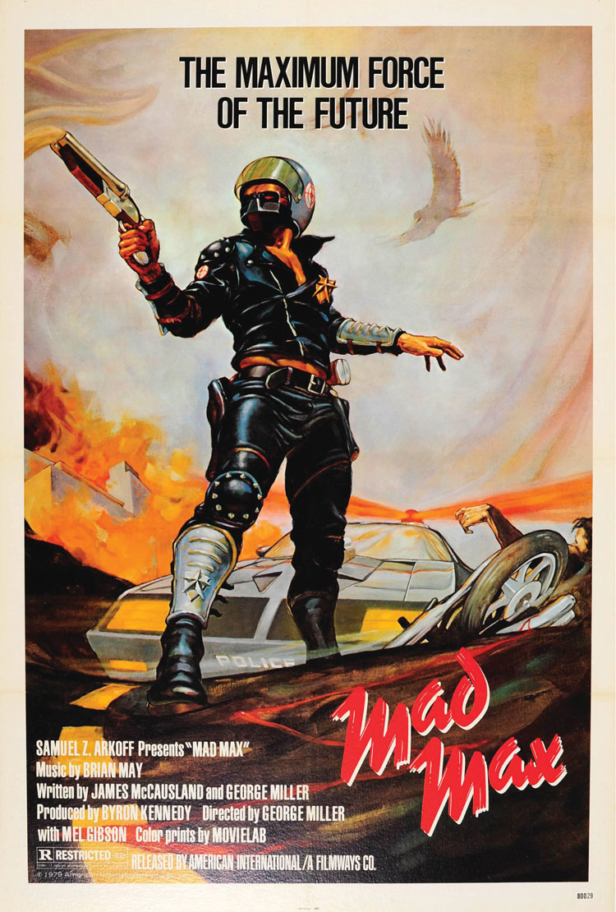Released back in 1979, George Miller’s breakout debut, Mad Max, still packs a mighty punch. While Mad Max 2 aka The Road Warrior (1981), Mad Max Beyond Thunderdome (1985) and the more recent Mad Max: Fury Road (2015) are better known and more widely seen by fans, the movie kickstarting one of the most iconic franchises of all time should not be forgotten. A pioneering sci-fi actioner made well outside the confines of Hollywood, Mad Max and its sequels spawned a wave of imitators.
A dystopian nightmare set in and around Melbourne, the Ozploitation masterpiece depicts a time and place bedevilled by demented biker gangs who have taken over the highways. A ragtag group of cops – known as the Main Force Patrol – engage them on the open road, fighting dirty to wrestle back control. The tit-for-tat skirmishes unfolds against a backdrop of social decay and a sense the world is falling apart rapidly. Amid the flesh and metal carnage carnival, a hero will rise, though he must first experience tragedy and the greatest loss.
The low-budget Mad Max broke box-office records upon its release. Until The Blair Witch Project came along 20 years later, Miller’s film was in the Guinness Book Of Records as the biggest money-earner of all time. Not too shabby. Audiences adored the death-defying stunts, memorable villains such as Hugh Keays-Byrne’s Toecutter and a rogue cop who out-crazies the baddies. Today, Max Rockatansky is up there with Ned Kelly, kangaroos, Dame Edna and the Sydney Opera House as among the county’s great icons.
While his Australian New Wave contemporaries were busy making well-received Victorian dramas, with films such as Picnic At Hanging Rock (1975) and My Brilliant Career (1979), a mild-mannered ex-emergency room doctor turned filmmaker fancied his cinema more in the key of rock ‘n’ roll. George Miller proved his country could make action movies on par with Hollywood and at a quarter of the budget. Looking back on the film, cinematographer David Eggby concluded the maverick spirit in which the film was made is truly reflected on the screen. “The stunts were very dangerous. [There were] no safety rules and regulations, back then.” He added: “I think what made the film so different was everyone – the actors, the crew, the stunt team – just went for it.”

Eggby’s work on Mad Max led to a varied career at home and abroad. He lensed sci-fi gems Pitch Black (2000) and Riddick (2013), as well as Raja Gosnell’s live-action Scooby-Doo (2002) and shot the thermal camera footage seen in Predator (1987). Not bad going for a London-born, ex-Royal Australian Navy photographer plucked from a day job making safety and training films for local government. The-then 27-year-old director of photography landed the job through a previous work connection to director Miller. “It was hard making a good living as an unknown freelancer in the early Seventies, so [I] supplemented my income doing various part-time jobs. I [then] took a full-time position at the State Electricity Commission of Victoria,” Eggby reminisces. “One day, out of the blue, I received a call from a guy called Byron Kennedy. He was looking for a cameraman for a movie he was producing called Mad Max and had been given my name as a cameraman that was good at action, by two directors I had worked with [previously] at Crawford Productions, Simon Wincer and the other, George Miller.”
The production was often fraught with incidents and accidents. At one point, Miller quit and producing partner Byron Kennedy rang up Brian Trenchard-Smith, who had previously made The Man From Hong Kong (1975), an action-packed Chinese-Aussie actioner (and a ground-breaking Ozploitation work in its own right) and inquired if he would take over. Trenchard-Smith’s advice was to hire instead a quality first assistant director to support the main man. After a couple of days, Miller rallied and completed the film, but it’s true the crew had little respect for him during the shoot.
Mad Max was the definition of a guerrilla production – low budget, big vision. Nobody understood or cared about the rules, they attempted action sequences never staged in Australia before, and did so without permits. It’s genuinely amazing nobody was killed. “There were a few accidents. Stunt co-ordinator Grant Page crashed out on a motorbike and broke his leg early on in production. Unfortunately, the original leading lady, Rosie Bailey, was riding pillion with Grant and she also broke her leg. They quickly recast [the role with] Joanna Samuel. [There was a] few close shaves, like coming face to face with quarry tip trucks refusing to acknowledge our crude attempt at traffic control.”

Although Miller would make extensive use of storyboards and pre-visualisation technology on later productions, Mad Max’s complicated action sequences were mounted without them. The script was written in the classic short-form, Egbby says, describing the action, camera details and dialogue. “I don’t remember any storyboard. I still have my original script, locked away. This was a different approach to action. It was very raw film-making.”
Shot almost entirely on location on the country lanes and roads around Melbourne and Geelong, with other locales dotted around the state of Victoria, the shoot presented plenty of continuity headaches for Eggby. “It is always hard to keep a visual continuity on a big exterior film and I’m sure if you were to scrutinise shot-by-shot, it varies a lot, but when the action is working it doesn’t matter. Have a look at Jaws and see how the water changes from shot-to-shot.” It’s very true. The fast-flowing action and editing means change in weather is barely noticeable for audiences, so caught up are they in the metal-on-metal carnage and chases. Today, errors of that nature are easily corrected in post-production, but as Eggby pointed out: “Remember, this was pre-CGI.”
Inspired by Sergio Leone’s Man With No Name trilogy, the film is visually striking because of the Cinemascope format and Miller deciding to place the camera at road level. Using Todd AO lenses shipped Down Under by Warner Bros. (the lenses had previously been used on Sam Peckinpah’s The Getaway, 1973) and located at a production house in Sydney, only one of the lenses in fact worked, but Miller and Eggby were able to achieve the distinct look they required through perseverance. Again, the issues with lenses demonstrate the troubled aspects of production – all the types of bullshit Hollywood movies don’t have to contend with: Dangerous set-pieces, lack of permits, nightmare logistics, knackered lenses.

“There was a set of Todd AO anamorphic lenses in Sydney at one of the rental houses. There weren’t many to choose from but enough focal lengths to shoot the movie. They were slow and needed constant recalibration, but they were beautiful bits of glass,” Eggby remembers.
The chase scenes are unlike anything put on screen before, letting the audience feel as if they’re on a roller-coaster. “The visual style of the film came from early talks with George Miller and Byron Kennedy about low, wide lenses skimming the road and letting the format enhance the highways, [it was] very Sergio Leone. The Cinemascope format was perfect. It was a once-in-a-lifetime chance to create something that hadn’t been done before,” Eggby explains.
Production stills show Eggby bravely riding pillion on a motorbike, which travelled between 80 and 185 kilometres-an-hour, holding the Arriflex camera on a shoulder. It looks positively bananas: “We just went fast. Look at the speedo on the Goose’s bike just before he crashes. It’s tipping 180kph. I know, I was hand holding an Arriflex 3BL as a pillion, getting a POV with a level horizon.”
Mad Max was less a case of ‘they don’t make ‘em like that anymore’ and more ‘they didn’t make ‘em like that back then, either’. Eggby risked life and limb to get those thrilling shots in the can, and he’s sanguine about the danger today. “We were all a bit gung-ho. Stupid and young, I guess,” is how he sums up the experience of his part in crafting a cinema classic.
Several scenes filmed back in 1977 never made it into the finished cut. But the shot of Max on a hillside graveyard isn’t one of them. At the start of Mad Max 2, there is a montage sequence, reintroducing us to Max’s sad story and the world’s descent into chaos and destruction. In black-and-white, Miller recuts scenes from the first film (as a sort of highlights reel) overlapped with old newsreel footage. Accompanying the line “he became a shell of a man, a burnt out, desolate man”, there is a shot (now in colour) of Max on a rocky hillside. He is wearing his original MFP uniform and uses a walking stick. We see two crucifixes in the ground, denoting this is where he has buried Sprog and Jess. The big question for fans: Is it a deleted scene from the first movie, reused for sequel? Egbby has the answer and confirms he didn’t shoot it: “I have no recollection of shooting the graveside scene on the original Mad Max. It was shot for the sequel.”
Mad Max Anthology is available on Blu-ray now from Warner Home Video.
